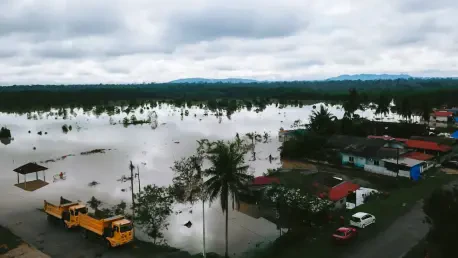In recent years, climate change has unveiled unprecedented challenges to industries worldwide, prompting the insurance sector to rethink its strategies to enhance resilience. The growing frequency and intensity of natural disasters have tested the financial fortitude of insurers and reinsurers, compelling them to adopt innovative approaches to risk management. Collaboration among academic, governmental, and industrial stakeholders is imperative to developing effective models for safeguarding insurance provisions. As extreme weather events become routine, the global insurance market must prioritize robust methodologies for quantifying, managing, and mitigating climate-related risks, ensuring continual access to essential coverage. This transformation necessitates a blend of heightened financial health, progressive policy adaptations, and comprehensive climate-risk integration. The insurance landscape thrives on the resilience of its foundational structures, marked by concerted efforts to navigate evolving climate dynamics.
Evolving Strategies for Climate Risk Management
Amid escalating climate threats, the insurance industry stands at a crossroads, demanding significant shifts in risk management strategies underpinned by scientific advances and fiscal prudence. Insurers are increasingly investing in climate risk modeling firms and leveraging academic research to refine predictive capabilities that inform premium pricing and policy framework adjustments. This synergy not only enhances accuracy but emboldens the industry to navigate complex climate scenarios, ultimately fostering safer and more robust insurance solutions. Within established economies like the US, EU, Japan, and Australia, the pursuit of viable insurance frameworks becomes crucial as insurers aim to safeguard properties. In scenarios where traditional methods falter, deploying AI-driven technologies provides insurers functional tools to anticipate hazards and expedite response mechanisms. This evolution frames the insurance sector’s reaction to climate exigencies.
As insurers recalibrate strategies, they confront rising repair costs due to climate-induced damages, necessitating a reevaluation of risk appetite, especially for high-risk residential zones. These areas—often located near coastlines and waterways—pose considerable challenges that compel insurers to adapt practices for viability. Policy adaptations thus emerge as pivotal in managing residential insurance, emphasizing sustainability intertwined with accountability. Regulatory pressures further complement these adjustments, underscoring the obligation for insurers to recalibrate pricing strategies reflecting forecasted climate impacts. Such measures integrate into a larger tapestry of financial resilience strategies, comprising enhanced retention rates and reinforced coverage frameworks, thus positioning insurers for successful navigation of elevated environmental threats. This collective effort underscores a strategic recalibration of industry practices aimed at ensuring preparedness amidst unpredictable climate shifts.
Innovations in Insurance Offerings Against Climate Risks
The rise in climate-related uncertainties triggers a wave of creative solutions within the insurance realm, reshaping traditional paradigms to accommodate novel offerings. Forward-thinking insurers explore parametric insurance solutions that hinge on meteorological data to provide more accurate, timely payouts. By linking compensation models to tangible parameters like water levels in flood-prone areas, such solutions seek to alleviate pressures from hurricanes without entangling traditional physical damage assessments, thereby offering robust financial safeguards. Collaborations, such as Aon’s partnership with Swiss Re Corporate Solutions, showcase these developments, providing pivotal insights into strategically mitigated losses while enhancing current coverage standards. These innovations extend beyond immediate financial protection, proposing an alteration in industry norms to integrate climate resilience comprehensively into product design.
Beyond individual product innovations, expertise in organizational resilience becomes a competitive advantage. Notable actors, such as Marsh, champion resilience by collaborating with enterprises to amplify climate risk management capabilities. With a focus on adaptation know-how, Marsh assists clients in evaluating impacts across assets, emergency protocols, supply chains, and regulatory frameworks, fostering a well-rounded resilience strategy. Such engagement heralds a progressive shift in managing systemic climate risks, stressing the proactive adoption of adaptive measures rather than reactive adjustments. This nuanced approach not only diversifies service offerings but bolsters the industry’s stance on resilience, encouraging transformations rooted in inclusive client-centric strategies drawn from varied implications of climate adversities.
Collaborative Efforts for Systemic Climate Solutions
The drive to fortify insurance resilience against climate risks finds its momentum in collective endeavors involving insurers, governments, and conservation entities. The partnership between Canada’s Nature Force and Ducks Unlimited Canada exemplifies these cooperative initiatives, investing in wetland restoration as a bulwark against urban flooding. These alliances foster not only environmental rehabilitation but mark crucial steps in reinforcing public-private sector collaboration, paving the road to standardized resilience protocols. Governmental engagement, crucial for scaling local resilience, revolves around enforcing modernized building codes, land zoning based on risk assessments, and establishing resilience benchmarks. These frameworks empower communities with insurable terrains while symbiotically enhancing infrastructure adaptability.
A unified vision among industry leaders and regulatory bodies echoes the thematic narrative that successful climate adaptation necessitates comprehensive multilateral efforts. Stakeholders—from academic to governmental—craft this narrative by driving cohesion across societal sectors. Enacting methodological responses hinges on shared priorities and recognition of climate change as transformative, not merely a circumstantial risk. This cohesive approach crafts diversified insurance capabilities, propelling a narrative grounded in resolute, forward-thinking strategies that accommodate climate uncertainties. As these partnerships thrive, insurance’s resilience emerges more streamlined, encapsulating a broader methodology that champions sustainable, inclusive adaptation to the consistent challenges posed by shifting climate realities.
Crafting a Resilient Insurance Future
In recent years, the insurance industry has faced significant hurdles due to climate change, which has affected industries globally, prompting a reevaluation of strategies to boost resilience. The increasing frequency and severity of natural disasters have challenged the financial robustness of insurers and reinsurers, urging them to innovate their risk management strategies. Collaborative efforts among academia, governmental bodies, and industry stakeholders are crucial in creating effective frameworks to safeguard insurance provisions. As extreme weather events become commonplace, the global insurance sector must prioritize strong methods for assessing, managing, and mitigating climate-related risks, assuring ongoing access to critical coverage. This transformation calls for a balanced approach, integrating enhanced financial stability, forward-thinking policy changes, and comprehensive climate-risk strategies. The insurance industry must rely on robust foundational structures and collaborative initiatives to navigate the changing climate landscape successfully.









